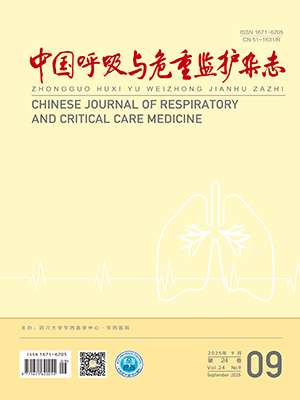| 1. |
Global Initiative for Chronic Obstructive Lung Disease. Global strategy for the diagnosis, management and prevention of chronic obstructive pulmonary disease 2019 report [EB/OL]. [2018-12-02]. Available at: https://goldcopd.org/gold-reports/.
|
| 2. |
Magnoni MS, Rizzi A, Visconti A, et al. AIMAR survey on COPD phenotypes. Multidiscip Respir Med, 2014, 9(1): 16.
|
| 3. |
Gu SY, Deng XJ, Li QY, et al. Gender differences of chronic obstructive pulmonary disease associated with manifestations on HRCT. Clin Respir J, 2017, 11(1): 28-35.
|
| 4. |
Bhaskar R, Singh S, Singh P. Characteristics of COPD phenotypes classified according to the findings of HRCT and spirometric indices and its correlation to clinical characteristics. Afr Health Sci, 2018, 18(1): 90-101.
|
| 5. |
Goddard PR, Nicholson EM, Laszlo G, et al. Computed tomography in pulmonary emphysema. Clin Radiol, 1982, 33(4): 379-387.
|
| 6. |
韩晓彧. 慢性阻塞性肺疾病患者高分辨率 CT 分型与气道炎症之间的关系[D]. 辽宁: 大连医科大学, 2018.
|
| 7. |
Tatsumi K, Kasahara Y, Kurosu K, et al. Clinical phenotypes of COPD: results of a Japanese epidemiological survey. Respirology, 2004, 9(3): 331-336.
|
| 8. |
Celli BR, Locantore N, Tal-Singer R, et al. Emphysema and extrapulmonary tissue loss in COPD: a multi-organ loss of tissue phenotype. Eur Respir J, 2018, 51(2): 1702146.
|
| 9. |
Rutten EP, Grydeland TB, Pillai SG, et al. Quantitative CT: associations between emphysema, airway wall thickness and body composition in COPD. Pulm Med, 2011, 2011: 419328.
|
| 10. |
Casanova C, de Torres JP, Aguirre-Jaíme A, et al. The progression of chronic obstructive pulmonary disease is heterogeneous: the experience of the BODE cohort. Am J Respir Crit Care Med, 2011, 184(9): 1015-1021.
|
| 11. |
Liang R, Zhang W, Song YM. Levels of leptin and IL-6 in lungs and blood are associated with the severity of chronic obstructive pulmonary disease in patients and rat models. Mol Med Rep, 2013, 7(5): 1470-1476.
|
| 12. |
梁卫娟, 华锋. CRP 和 TNF-α 在慢阻肺急性加重期病情严重程度判断中的意义. 中国现代医生, 2015, 53(9): 12-15.
|
| 13. |
Borsi H, Nia EP, Mal-Amir MD, et al. Relationship between serum procalcitonin level and chronic obstructive pulmonary disease. J Family Med Prim Care, 2019, 8(2): 738-740.
|
| 14. |
Günay E, Sarınç Ulaşlı S, Akar O, et al. Neutrophil-to-lymphocyte ratio in chronic obstructive pulmonary disease: a retrospective study. Inflammation, 2014, 37(2): 374-380.
|
| 15. |
Rahimi-Rad MH, Asgari B, Hosseinzadeh N, et al. Eosinopenia as a marker of outcome in acute exacerbations of chronic obstructive pulmonary disease. Maedica (Buchar), 2015, 10(1): 10-13.
|
| 16. |
陆召辉, 杨刚, 金炬, 等. 慢性阻塞性肺疾病急性加重期嗜酸性粒细胞水平与预后关系的分析. 临床肺科杂志, 2017, 22(3): 407-410.
|
| 17. |
Zhang M, Li YL, Yang X, et al. Serum cystatin C as an inflammatory marker in exacerbated and convalescent COPD patients. Inflammation, 2016, 39(2): 625-631.
|
| 18. |
Kitaguchi Y, Fujimoto K, Kubo K, et al. Characteristics of COPD phenotypes classified according to the findings of HRCT. Respir Med, 2006, 100(10): 1742-1752.
|
| 19. |
Tomaro ML, Batlle AM. Bilirubin: its role in cytoprotection against oxidative stress. Int J Biochem Cell Biol, 2002, 34(3): 216-220.
|
| 20. |
蔚京京, 赵卉, 李建强. 胆红素在肺气肿动物模型中发挥保护作用的机制研究. 中华结核和呼吸杂志, 2016, 39(8): 637-641.
|
| 21. |
Hu GP, Wu YK, Zhou YM, et al. Cystatin C as a predictor of in-hospital mortality after exacerbation of COPD. Respir Care, 2016, 61(7): 950-957.
|
| 22. |
Zhang Y, Zhu Y, Wu Y, et al. Serum cystatin C as a potential biomarker for the evaluation COPD. Int J Clin Exp Med, 2014, 7(12): 5484-5490.
|




